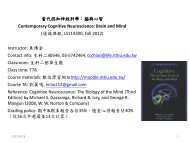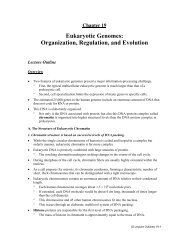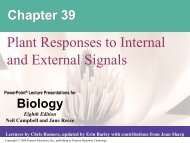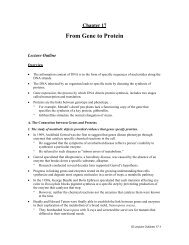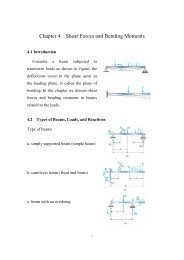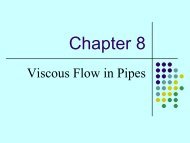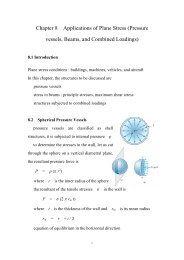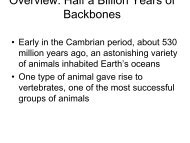Applications of Diagonalization
Applications of Diagonalization
Applications of Diagonalization
Create successful ePaper yourself
Turn your PDF publications into a flip-book with our unique Google optimized e-Paper software.
<strong>Applications</strong> <strong>of</strong> <strong>Diagonalization</strong>Hsiu-Hau Linhsiuhau@phys.nthu.edu.tw(Apr 12, 2010)The notes cover applications <strong>of</strong> matrix diagonalization (Boas 3.12).• Quadratic curvesConsider the quadratic curve,5x 2 − 4xy + 2y 2 = 30. (1)It can be casted into the matrix form and then brought into diagonal form,(x, y)(5 −2−2 2) (xy)= 30 → (x ′ , y ′ )(1 00 6) (x′y ′ )= 30. (2)The similarity transformation brings the quadratic curve into the canonicalform x ′2 + 6y ′2 = 30. This is clearly an ellipse with principle axes coincidewith the eigenvectors.• Harmonic oscillators with equal massConsider three identical springs attached to two equal masses in series. Theelastic potential energy isV (x, y) = 1 2 kx2 + 1 2 k(x − y)2 + 1 2 ky2 . (3)The corresponding equations <strong>of</strong> motions aremẍ = −∂V/∂x = −2kx + ky, (4)mÿ = −∂V/∂y = kx − 2ky. (5)Assume the solutions are x = x 0 e iωt and y = y 0 e iωt , the equations can bewritten in matrix form,(xλy)=(2 −1−1 2) (xy), (6)
HedgeHog’s notes (April 11, 2010) 2where λ = mω 2 /k. The potential matrix is symmetric arisen from Newton’sthird law. Following the standard recipe for matrix diagonalization, theeigenvalues are λ = 1, 3 corresponding to the characteristic frequenciesω 1 =√km , ω 2 =√3km . (7)The eigenvectors for the coupled harmonic oscillators arer 1 = (1, 1), r 2 = (1, −1). (8)The in-phase oscillation mode has a smaller frequency ω 1 while the out-<strong>of</strong>phasemode has a larger frequency ω 2 = √ 3ω 1 .• Harmonic oscillators with different massesConsider the same setup but the spring constants and the masses are notequal: 2k, 2m, 6k, 3m, 3k. The potential energy isand the kinetic energy isV (x, y) = 1 2 (2k)x2 + 1 2 (6k)(x − y)2 + 1 2 (3k)y2= 1 2 k(8x2 − 12xy + 9y 2 ), (9)T = 1 2 (2m)ẋ2 + 1 2 (3m)ẏ2 = 1 2 m(2ẋ2 + 3ẏ 2 ). (10)There are two different ways to solve the problem. Let’s try the easier onefirst. The equations <strong>of</strong> motion are−2mω 2 x = −k(8x − 6y), (11)−3mω 2 y = −k(−6x + 9y). (12)Divide each equation by its mass and write the equations in matrix form,( ) ( ) ( )x 4 −3 xλ =, (13)y −2 3 ywith λ = mω 2 /k. The eigenvalues and the eigenvectors areλ = 1, r = (1, 1); (14)λ = 6, r = (3, −2). (15)
HedgeHog’s notes (April 11, 2010) 3The main problem with this approach is that the eigenvectors are not orthogonalanymore. Sometimes, this is not a problem and I would recommend thisapproach. However, there are times that the orthogonality is important andwe need another more advanced approach.Let’s write both the potential and the kinetic energy in matrix form,( )8 −6V = 1k 2 rT V r where V =, (16)T = 1 2 k rT T r where T =−6 9)(2 00 3The equation <strong>of</strong> motion can be written in matrix form,. (17)λT r = V r. (18)Since the matrix T is positive definite, we can define its square-root matrix( √ )T 1 22 0= √ . (19)0 3Perform a simple scaling transformation to new coordinates,(XR =Y) ( √ ) ( )2 0= √ x= T 1 2 r. (20)0 3 yThe equation <strong>of</strong> motion can be rewritten in the standard form,λR = T − 1 2 V T− 1 2 R. (21)The matrix T − 1 2 V T − 1 2is now symmetric and all nice properties are recovered.• Quasi-species equationsIn addition to the basic examples in the textbook, I would like to sharewith more advanced applications for evolutionary dynamics. To describe theevolution <strong>of</strong> frequencies for different species in the fitness landscape, quasispeciesequations capture the essential ingredient,dx idt = ∑ jx j f j q ji − φx i , (22)where x i and f j are the frequency and the fitness for the j-th sequence andφ = ∑ i x i f i is the average fitness for all sequences. The mutation probability
HedgeHog’s notes (April 11, 2010) 51.21.21.01.00.80.80.60.60.40.40.20.20 5 10 15 20 25 300 5 10 15 20 25 30Figure 1: For the single-peak fitness landscape, there exists a mutationthreshold u c . For u < u c , frequency pr<strong>of</strong>ile is localized near the fitness peak.On the other hand, for u > u c , an extended state (not necessarily uniform)emerges and the notion <strong>of</strong> quasi-species no longer exists.The frequency in the infinite-time limit thus only depends on the groundstatewave function Φ 0 i ,⎛⎞x ∗ 1i = lim x i (t) = ⎝t→∞ ∑j Φ 0 j/ √ ⎠ √ 1 Φ 0 i . (30)f fi jTherefore, to compute the survival frequencies, we only need to find theground state <strong>of</strong> the effective Hamiltonian.Consider the simplest fitness landscape as shown in Fig. 1. There existsa sharp peak with maximum fitness f 0 = f M and the background fitnessf i = f < f M for all sequences i ≠ 0. Note that the effective Hamiltonian isreal and symmetric,√H ij = − f i f j u d ji(1 − u) L−d ji. (31)Even though the single-peak fitness landscape is simple, the size <strong>of</strong> the sequencespace is huge N s = 2 L . Following Chun-Chung’s suggestion, theground state must be in the “s-wave” sector with a much small size L only,√1Ψ 0si = (1, 0, 0, ..., 0), Ψ 1si =L√Ψ 2si =(0, 1, 1, .., 1, 0, 0, ..0),2(0, 0, 0, .., 0, 1, 1, ...., 1, 0, 0, ..., 0), ... (32)L(L − 1)where the non-zero components in Ψ 1si are with the distance d = 1 from thepeak and similar properties hold for all other Ψ nsi . One can construct theL × L Hamiltonian in the s-wave sectorH nm = ∑ ijΨ nsi H ij Ψ msj , (33)
HedgeHog’s notes (April 11, 2010) 6and numerically diagonalize the Hamiltonian to obtain the ground state. Thes-wave symmetry helps tremendously and reduces the size <strong>of</strong> the relevantsequence space from N s = 2 L to just L!• Variational methodHere I am going to use a variational approach to estimate the mutationthreshold. Choose two variational wave functionsΨ 0 i = (1, 0, ..., 0), Ψ 1 i =1√ (0, 1, 1, ..., 1). (34)Ns − 1Construct the variational wave function for the ground stateΨ i = c 0 Ψ 0 i + c 1 Ψ 1 i , (35)with the normalization constraint c 2 0 + c 2 1 = 1. The variational energy takesthe formE(c 1 , c 2 , λ) = ∑ Ψ i H ij Ψ j + λ(c 2 0 + c 2 1),ij∑= c n Hnmc v m + λ(c 2 0 + c 2 1), (36)n,m=0,1where the variational Hamiltonian isH v nm = ∑ ijΨ n i H ij Ψ m j . (37)The matrix elements <strong>of</strong> the variational Hamiltonian can be computed,H00 v = −f M (1 − u) L , (38)√H01 v = H10 v fM f [= −] 1 − (1 − u)L, (39)N s − 1H11 v = − f ∑u d ij(1 − u) L−d ijN s − 1i,j≠0⎛⎞= − f ⎝ ∑−∑ ⎠ u d ij(1 − u) L−d ijN s − 1i≠0,ji≠0,j=0= −f + f [ ] 1 − (1 − u)L. (40)N s − 1
HedgeHog’s notes (April 11, 2010) 7Minimizing the variational energy E(c 1 , c 2 , λ) is equivalent to diagonalizingthe 2 × 2 variational Hamiltonian H v nm which can be rewritten as( )−ɛ −∆Hnm v = C1 + f, (41)−∆ ɛwhere the constant term does not affect the frequencies x i (t) after the inversegauge transformation,C = − 1 2[f M q 00 + f −f]N s − 1 (1 − q 00)(42)with q 00 = (1 − u) L and will be dropped in the following calculations. Thedimensionless parameters ɛ and ∆ in the variational Hamiltonian areɛ(u, r, L) = 1 [r(1 − u) L − 1 ] 1 [+] 1 − (1 − u)L, (43)22(N s − 1)√ r [∆(u, r, L) =] 1 − (1 − u)L, (44)N s − 1where r = f M /f is the relative fitness <strong>of</strong> the dominant sequence and N s = 2 Lis the size <strong>of</strong> the sequence space. The eigenvalues <strong>of</strong> the variational HamiltonianareE ± = ± √ ɛ 2 + ∆ 2 . (45)Therefore, the ground-state energy within the variational approximation correspondsto the negative eigenvalue E = E − with the eigenvectorc 0c 1=√∆√ɛ2 + ∆ 2 − ɛ = ɛ2 + ∆ 2 + ɛ. (46)∆• Survival frequency and back mutationsWith the coefficients c 0 and c 1 at hand, the ground state within the variationalapproximation isΦ v0i =(c 0 ,)c√ 1Ns − 1 , c√ 1Ns − 1 , ..., c√ 1. (47)Ns − 1
HedgeHog’s notes (April 11, 2010) 81.0x 0⋆1.0x 0⋆0.80.80.60.60.40.20.00 0.02 0.04 0.06 0.08 0.10 0.12u0.40.20.5 1.0 1.5 2.0uLln rFigure 2: The frequency x 0 <strong>of</strong> the dominant sequence plotted versus the pointmutation u and the rescaled mutation g = uL/ ln r. The fitness landscapeconsists <strong>of</strong> a single sharp peak with relative fitness r = f M /f = 2 and auniform background for all other sequences. The genome length starts fromL = 10 (red) to L = 22 (purple). From the left panel, it is clear thatthe crossover (from localized-like to extensive-like) becomes sharper as thegenome length increases. For the given relative fitness r = 2, all curves forx ∗ 0(u, r, L) can be collapsed onto the universal scaling function by changingthe variable to g = uL/ ln r. It is clear that the mutation threshold is g c = 1.The survival frequency <strong>of</strong> the dominant sequence can be computed from thevariational ground state,x ∗ 0(u, r, L) ==⎛⎞1⎝∑j Φ v0j / √ ⎠ √ 1 Φ v0 c 00 = √f f0 j c 0 + r(N s − 1)c 1√ɛ2 + ∆ 2 + ɛ√ɛ2 + ∆ 2 + ɛ +√r(2 L − 1)∆ . (48)It is convenient to introduce the rescaled variable g for mutations,g = uLln r . (49)The numerical plot for x ∗ 0(u, r, L) is shown in Fig. 2 and it scales rathernicely when plotting versus the rescaled variable g = uL/ ln r (as long as Lis sufficiently large) with a sharp transition at g c = 1.How good is the “no-back-mutation” assumption? A good indicator isthe ratio <strong>of</strong> the back-mutating rate and the rate to stay on the dominantsequence,χ(u, r, L) =∑j≠0 x ∗ jf j q j0x ∗ 0f M q 00. (50)
HedgeHog’s notes (April 11, 2010) 9Χ1.41.21.00.80.60.40.20.00 0.02 0.04 0.06 0.08 0.10 0.12 0.14u1.41.21.00.80.60.40.2Χ0.0 0.5 1.0 1.5 2.0uLln rFigure 3: The back-mutation ratio χ(u, r, L) plotted versus the mutation u(left panel) and the rescaled mutation g = uL/ ln r (right panel). The parametersare the same as those in Fig. 2. For large enough genome length, theback-mutation rate is indeed negligibly small when compared with the rateto stay in the dominant sequence. However, beyond the mutation threshold,the ratio χ grows exponentially, hinting the enhanced back mutations destroythe localized state and prefer the extended state.Within the variational approximation, all x ∗ j = x ∗ 1 for j ≠ 0 and the summationin the numerator can be carried out without difficulty,√χ(u, r, L) = x∗ 1f 1 (1 − q 00 ) f 1 − q 00 c 1=. (51)x ∗ 0f 0 q 00 f M q 00√(N s − 1)c 0For finite genome length, the back mutations exist as shown in Fig. 3. However,the no-back-mutation assumption is reasonably good. Notice that, plottedwith the rescaled mutation g = uL/ ln r, the data for different lengths collapsenicely into a universal curve. Above the mutation threshold g > g c = 1,the back mutations grow exponentially and destroy the localized quasi-speciesstate in the sequence space.• Infinite genome-length limitInspired by the nice collapse onto universal curve, it is interesting to take theinfinite genome-length limit and derive the scaling functions for the survivalfrequency for the dominant species and the back-mutation ratio. TakingL → ∞ limit but keeping the rescaled mutation g and the relative fitness rfinite, the exponential factor becomeslimL→∞ (1 − u)L = limL→∞e L ln(1−u) = limL→∞e −uL = e −g ln r = r −g .
HedgeHog’s notes (April 11, 2010) 10x ⋆ 0 g,r1.0x ⋆ 0 g,L1.00.80.80.60.60.40.40.20.0 0.2 0.4 0.6 0.8 1.0 1.2 1.4g0.20.0 0.2 0.4 0.6 0.8 1.0 1.2 1.4gFigure 4: The universal scaling function x ∗ 0(g, r) in the infinite-length limit(left panel) and x ∗ 0(g, L) in the continuous limit (right panel). Taking thegenome length to infinity, survival frequencies for the dominant sequencewith different mutation u and length L collapse onto the universal scalingfunction x ∗ 0(g, r). The transition is sharp and the universal scaling functionsvary with different relative fitness from r = 1 + (red) to r = 13 (purple). Onthe other hand, in the continuous limit (u → 0 and r → 1 + ), the scalingfunction x ∗ 0(g, L) is not necessarily sharp anymore since the genome lengthis finite, varying from L = 4 (red) to L = 16 (purple). Note that the scalingfunction in both infinite-length and continuous limit is just the linear functionx ∗ 0(g) = 1 − g below the error threshold g c = 1.In addition, the <strong>of</strong>f-diagonal term ∆ is negligibly small and the survivalfrequency for the dominant sequence is greatly simplified,x ∗ 0(g, r) = limL→∞x ∗ 0(u, r, L) =12 [|r1−g − 1| + (r 1−g − 1)]12 [|r1−g − 1| + (r 1−g − 1)] + r(1 − r −g ) . (52)Since the relative fitness r is greater than unity, the numerator is zero forg > 1. It is straightforward to show the universal scaling function isx ∗ 0(g, r) = Θ(1 − g) r1−g − 1r − 1 . (53)Magically, this form is exactly the same as that derived under the assumption<strong>of</strong> no back mutation.We can also compute the back-mutation ratio in the infinite genomelengthlimit. Taking L → ∞ but keeping g and r finite, the stay-on probabilityis q 00 = (1 − u) L → r −g . The only tricky term in χ(g, r) islimL→∞c 11 − r√(N 1−g= Θ(g − 1) √s − 1)c 0 r(1 − r−g) . (54)
HedgeHog’s notes (April 11, 2010) 11Therefore, the back-mutation ratio in the infinite genome-length limit isχ(g, r) = Θ(g − 1) ( r g−1 − 1 ) . (55)The universal ratio χ(g, r) is zero in the localized quasi-species state, i.e.back-mutation rate can be safely ignored.• Continuous limitFollowing Chun-Chung’s idea, the continuous limit for Eigen’s model can beobtained by taking r → 1 and u → 0 but holding g and L finite. In thecontinuous limit,ɛ c (g, L) ≡ limr→1∆ c (g, L) ≡ limr→1ɛr − 1 = 1 [1 − g + g ],2 2 L − 1(56)∆r − 1 = 1√ g.2L − 1(57)After some algebra, the survival frequency <strong>of</strong> the dominant sequence x ∗ 0(g, L)in the continuous limit is√ɛ2x ∗ c + ∆ 2 c + ɛ c0(g, L) = √ɛ2c + ∆ 2 c + ɛ c + g . (58)If we take both continuous and the infinite-length limits together, thescaling function becomesr 1−g − 1limr→1 x∗ 0(g, r) = Θ(1 − g) limr→1 r − 1= Θ(1 − g) × (1 − g). (59)It is interesting that the back mutation disappear in this limit completely,lim χ(g, r) = Θ(g − 1) limr→1 r→1 (rg−1 − 1) = 0. (60)




